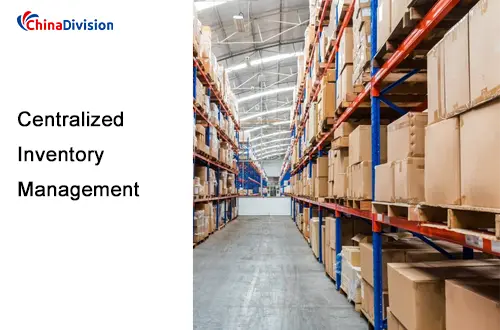Advantages and Solutions of Centralized Inventory Management
Inventory management is no longer a simple "purchase, sale and inventory", but a core competitiveness that determines the survival of cross-border e-commerce. A bad review caused by a stock out and a batch of backlogs swallowed up profits are enough to keep sellers awake at night.
Table of Contents
- Inventory Management Pain Point Scenarios
- What is the main purpose of inventory management?
- Analysis of inventory management types
- Centralized Inventory Management VS Decentralized Inventory Management
- Four core values of Inventory Management
- What is the most important part of inventory management?
- Common questions for B2B companies and e-commerce sellers
- Advantages of centralized inventory management
- Chinadivision Inventory Management Service Highlights
- Inventory management is not just inventory, but strategy!
Accurate inventory management is the cornerstone of on-time order delivery, effective cost control, and improved customer satisfaction. Are you still worried about the chaos of inventory in multiple warehouses? Losing customers due to unstable cross-border delivery timeliness? Being eroded by high warehousing costs? Inventory backlogs occupy precious cash flow?
As a leading international logistics fulfillment service provider, Chinadivision is committed to helping B2B companies and e-commerce sellers achieve inventory visualization, rapid allocation and accurate fulfillment through professional inventory management solutions.
Inventory Management Pain Point Scenarios
Out-of-stock during peak seasons leads to customer loss, and backlogs during off-seasons occupy funds;
Multiple warehouse data are not synchronized, and overselling leads to customer complaints;
Logistics delays lead to low inventory turnover and soaring storage costs.
Data warning: According to statistics, 34% of retail companies lose more than 10% of their annual revenue due to inventory management errors. The complexity of international logistics (such as cross-border customs clearance and multi-country warehousing) makes this problem worse.

What is the main purpose of inventory management?
Optimize inventory levels: avoid inventory backlogs and out-of-stock phenomena, and ensure that inventory levels match sales trends through demand forecasting (Demand Forecasting).
Increase order fulfillment speed: ensure efficient delivery, reduce delays, and shorten delivery time in combination with global warehousing layout.
Reduce operating costs: reduce storage space waste and labor costs, and reduce "hidden expenses" such as storage fees, insurance premiums, and depreciation fees.
Improve customer satisfaction: shorten delivery cycle and enhance consumer trust
Accelerate capital turnover: For every increase in inventory turnover, the company's cash flow can increase by tens of thousands of dollars.
Analysis of inventory management types
1. ABC classification method
Class A (20% SKUs contribute 80% of sales) → Daily monitoring, safety stock = daily average of the past 30 days × 45 days
Class B → Weekly monitoring, safety stock × 30 days
Class C → Monthly monitoring, safety stock × 15 days
2. Just-In-Time (JIT)
Applicable to high-turnover, small-volume 3C accessories.
Through "air express + pre-quality inspection", a "7-day replenishment window" is achieved.
3. Safety Stock + Reorder Point
Formula: Reorder Point = (average daily sales × procurement cycle) + Safety Stock
4. Cross-Docking
Full container shipping directly to Chinadivision Shenzhen Hub, sorting within 24 hours → direct shipment to overseas consumers, saving 30% of storage fees.
5. Hybrid (Centralized + Decentralized)
Core SKUs share inventory in the Central warehouse, and long-tail SKUs are pre-placed in the satellite warehouse of the destination country.
Centralized Inventory Management VS Decentralized Inventory Management
Centralized Inventory Management (Centralized Inventory Management)
All inventory is stored in a strategic location (such as an international hub warehouse close to the production site or core market).
Advantages:
Global visibility: a single inventory pool, the status is clear at a glance.
Economy of scale: reduce unit storage costs and optimize procurement discounts.
Inventory optimization: reduce the overall safety inventory and reduce the risk of stagnation.
Efficient allocation: unified management of replenishment and allocation strategies.
Applicable scenarios:
Concentrated sales areas; large product volume/high weight (reducing the cost of sharing multiple warehouses); strict inventory control is required (such as high-value electronic products).
Challenges:
The delivery time to the end market may be slightly longer (need to be combined with an efficient logistics network).
Decentralized Inventory Management (Decentralized Inventory):
Inventory is distributed in multiple warehouses in different regions/countries (such as forward warehouses and overseas warehouses).
Advantages:
Closer to end customers, shorten delivery time, and improve local market response speed.
Applicable scenarios:
Sales cover multiple countries; products are time-sensitive (such as fresh food, fast-moving consumer goods); need to avoid tariff risks (such as deploying inventory to the target market in advance).
Challenges:
Inventory data is fragmented, the overall inventory level is prone to be high, cross-warehouse transfers are complex, and management costs increase.
Hybrid mode: Combining the advantages of centralized and decentralized. For example, bulk goods are stored in hub warehouses with lower costs, and hot-selling SKUs are prepared in advance to overseas warehouses in various places according to forecasts. This is usually the best strategy and the core model for ChinaDivision to empower customers.
Four core values of Inventory Management
Cost control revolution
Warehousing cost compression: Accurately allocate storage resources through ABC classification (Class A products account for 5% of SKUs but contribute 70% of sales), reducing 30% of invalid storage capacity
Accelerated capital turnover: The dynamic safety inventory model reduces the risk of unsalable goods by 62%, releasing $200,000/month cash flow
Supply chain resilience upgrade
Risk hedging mechanism: Decentralized Inventory to deal with regional out-of-stock, centralized Inventory to reduce cross-border logistics costs
Anti-volatility: Real-time demand forecasting system to deal with seasonal fluctuations, out-of-stock rate reduced from 15% to 3%
Customer experience transition
Performance time guarantee: Intelligent inventory allocation ensures that 98% of orders are shipped within 24 hours, and the return rate is reduced to 2.1%
Precise delivery commitment: Multi-level inventory warning system realizes "pre-sale goods 7 days in advance"
Data-driven decision-making
Visual dashboard: Real-time tracking of inventory levels in 50+ warehouses around the world, automatic generation of replenishment heat map
Diagnostic report: Output inventory health score every month to identify unsalable/out-of-stock/excess SKUs
What is the most important part of inventory management?
Real-time Inventory Tracking
Automatic replenishment reminders and purchasing suggestions
Intelligent SKU classification and picking logic optimization
Efficient linkage with sales system
All of these have been integrated into Chinadivision's intelligent warehousing system, helping sellers get rid of complicated operations and making fulfillment simpler and more efficient.
Common questions for B2B companies and e-commerce sellers
What is Inventory Management?
Inventory Management ≠ simply "recording inventory", but "putting the correct quantity, correct SKU, at the right time, in the warehouse closest to the consumer, and completing fulfillment at the lowest comprehensive cost
How to choose centralized inventory or decentralized inventory?
It is recommended to evaluate based on product types, order geographical distribution and customer timeliness requirements. Chinadivision provides simulated transfer analysis reports to help users make accurate decisions.
Is central inventory management likely to cause slow inventory turnover?
Not necessarily. Centralized Inventory can optimize procurement and replenishment strategies through predictive algorithms. The key lies in combining an efficient fulfillment system with real-time inventory data.
Advantages of centralized inventory management
Improve inventory accuracy and visibility: The unified system provides real-time inventory data, prevents duplicate orders, and reduces errors.
Reduced costs: Reduce storage, staffing, and maintenance costs by minimizing the number of warehouse sites.
Excellent fulfillment efficiency: The central hub enables faster, more centralized shipments and bulk purchase transactions, supporting economies of scale.
Simplified supply chain: The integrated system can promote better supplier coordination, shorten delivery time, and improve delivery reliability.
Easier to expand: Due to simplified supervision, it is easier to manage the growth of order volume or new product lines.
Chinadivision Inventory Management Service Highlights
Global warehousing network + multi-platform docking (support Shopify, Amazon, eBay, etc.)
Product classification storage and security
Real-time data statistics and inventory health analysis
Fast inventory turnover and accurate delivery
Dedicated account manager and technical support collaboration
Inventory management is not just inventory, but strategy!
Want to make inventory no longer a cost center, but an engine of business growth? Chinadivision provides you with the most professional and intelligent inventory management and fulfillment services. From centralized inventory From inventory management to global transfer solutions, we help every e-commerce seller and B2B brand control inventory, ship quickly, reduce costs, and achieve growth goals.
Whether it is centralized or decentralized inventory, the core goal is to achieve faster delivery at a lower cost. Chinadivision helps sellers solve inventory problems through technology + global network + localized services, so that every product can reach customers in the best way.





